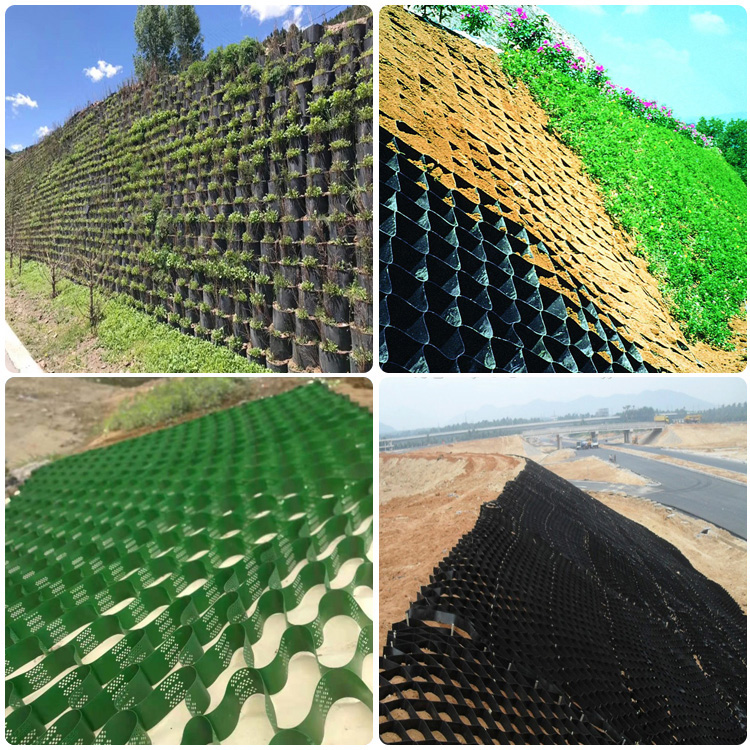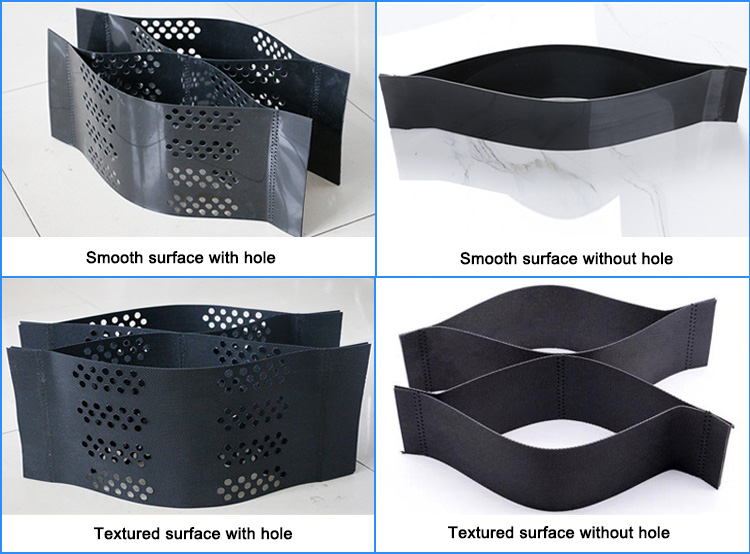1: Geocell grass planting slope protection technology brief introduction:
Geocell grass planting slope protection technology refers to a slope protection technology that fills the geocell chamber that is unfolded and fixed on the slope surface with planting soil, and then hangs a three-dimensional vegetation net on it, and evenly sprays grass seeds for greening. The use of geocells provides a stable and good living environment for the growth of lawn plants. This method can make the slope of the barren land fully green, and the geocell with holes can also increase the drainage performance of the slope, and it is convenient for construction, light in material, wear-resistant, stable in chemical properties, resistant to light and oxygen aging, and acid and alkali resistant, good adjustability, suitable for different soils and slopes, high survival rate of spraying greening, smooth and beautiful slope sides, good stability for slope protection, often used for slope greening protection.
 2:The advantages of geocell planting grass slope protection:
2:The advantages of geocell planting grass slope protection:
(1) Ecological beauty: better water permeability, moisture retention and soil preservation, which is conducive to vegetation growth; more than 98% of the open area almost no engineering traces; the flexible structure adapts to and retains the natural terrain to the greatest extent. Forms an effective slope protection and effective restraint structure for topsoil, vegetation and granular materials such as sand, gravel and larger rocks or stones. Compared with ordinary slopes, steeper slopes (slope ≤ 63°) are allowed to reduce the occupation of valuable land space.
(2) Energy saving and environmental protection: low-quality or local materials can be used as fillers, and less concrete is used. Concrete-filled geocells form flexible concrete pads with built-in expansion joints. For steep slopes, or slopes with geomembrane or hard soil/rock that prevent brazing, or slopes and embankments with loose gravel and sand that cannot be brazed, the anchorage of the top of the slope can provide additional stability.
(3) Through the vegetation root system, the geocell, upper and lower layers of soil, non-woven geotextiles, etc. are combined into a whole multi-layer protective structure. To solve the problem of slope topsoil stability and slope protection, the geocell slope stability and protection system can isolate, strengthen and bind the soil layer and filling above the slope, thereby controlling the downward movement and slippage of the slope caused by hydraulic and gravity .

(4) The flexible structure adapts to the settlement and deformation of the foundation, the geocell slope protection anchored at the top, and the slope protection suitable for long-term immersion and root scour conditions.
(5) The geocell land retention system solves the problem of soil stability on steep slopes. When the geocell system is stacked in layers, it can form an economical retaining wall that meets all the specific structural requirements of the project. The system is structurally flexible and aesthetically pleasing through fully vegetated walls. The outer geocells expose the horizontal terraces formed by the fill, allowing vegetation to thrive. The system captures rainwater and controls groundwater evaporation, creating a more natural environment for vegetation.

(6) Even in a soft soil environment, it can resist all loads generated by the quality of the filler and internal friction, and maintain structural stability. Adapts to site challenges when the substratum is compressible or when constructing in difficult-to-access locations. It takes up less valuable land space and has better slope stability.